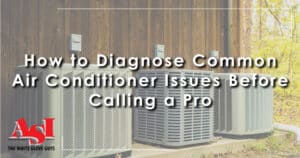Most homeowners know the basics of their appliances, but not all the ins and outs of how they work and how each component plays a role. After all, that’s why you hire professionals for AC installation, maintenance, and repairs, such as the pros at ASI Hastings Inc.
Being in business for over 70 years in the San Diego area, our technicians know all there is to know about air conditioners, their components, and how they operate. We’re happy to share that knowledge with you so you can better understand your AC’s function, how to tell if it’s operating properly, and why it may need repairs.
Though every component is important, two of the essential pieces of your AC’s operation are the condenser and evaporator coils. Learn more about what these coils do and how they keep your home cool.
First, How Air Conditioning Systems Work
Air conditioners come in many types with many features, but they all operate on the same basic premise. Air conditioners provide cold air inside your home or enclosed space by removing heat and humidity from the indoor air, transferring it outside, and returning cooled air into your home.
Standard air conditioners use specialized chemicals called refrigerants, which have three main mechanical components: a compressor, condenser coil, and an evaporator coil. These components work together to convert refrigerant from a gas to a liquid and back again.
Here’s how the coils come into play:
Evaporator Coil

Evaporator coils are made of a tubing that’s coiled around in a circular form inside the air handler, an interior portion of your AC system. Evaporator coils are made from copper, steel, or aluminum, since these metals conduct heat easily. The tubing houses refrigerant, which is kept cool using a cooling mechanism, and set into panels.
The panels are positioned in the form of an “A” and lined with thin pieces of metal called “fins.” These fins bring the passing air in to be cooled closer to the coils for maximum refrigerant effect.
The indoor unit is what takes in the warm air, which then passes over a coil full of cold, low-pressure liquid refrigerant. Before entering the evaporator coil, the refrigerant passes through the expansion valve, which releases pressure from the liquid refrigerant to cool it. The liquid refrigerant leaving the expansion valve is cold, which allows it to absorb heat from the air.
The expansion valve controls how much refrigerant flows into the evaporator as well. Advanced expansion valves, such as thermostatic expansion valves, can control the flow precisely to improve energy efficiency.
While the refrigerant flows, the blower fan draws hot room air over the evaporator coil. The refrigerant absorbs the heat from the air, and by extension, warms it up and it evaporates.
Once water vapor from your warm indoors hits the cold refrigerant in the evaporator coils, it condenses into a liquid and drips into the condensate pan, which drains the water outdoors. The entire process is how your home’s humidity is reduced.
Condenser Coil

Condenser coils are coils of tubing that are designed to help cool the air. However, they differ from evaporator coils because they are responsible for the opposite aspect of the cooling process. The gaseous refrigerant hits the condenser coil from inside your home, which is then compressed into a space that’s too small.
The condenser is housed in the large unit outside of your home. The entire unit is known as the “condenser unit,” but there are multiple components, including a fan, fins, a compressor, and the condenser coils.
Once the refrigerant absorbs heat from inside your home, it flows through a copper tube to the condenser unit. The low-pressure, warm refrigerant gas enters the compressor, which pressurizes the refrigerant and turns it into a hot, high-pressure gas.
The gas flows from the compressor into the condenser coils and the refrigerant releases the heat that was inside your home. The fan at the top blows air over the condenser coils to facilitate the process of the refrigerant releasing heat. Multiple condenser coils increase the time the refrigerant is exposed to the fan, ensuring that as much heat as possible is released.
As the refrigerant cools, it changes from a hot gas to a hot liquid. It then flows back through the copper tubing into your home and into the expansion valve in the indoor unit.
This process leads the refrigerant to release the heat that’s been absorbed from your indoor air and return it to a liquid. The liquid refrigerant is sent back to the indoor unit to start the process all over again, while a fan blows through the condenser coil passages to transfer the hot air outside.
Common AC Coil Problems
AC coils can encounter issues that affect your AC’s operation or efficiency, making it work harder than necessary. Worse, some issues can cause your AC to fail completely. Here are the common issues that may arise with AC coils:
Dirty Coils

Dirty coils can reduce the efficiency of your AC unit by restricting airflow. Dust, dirt, and debris can accumulate on the coils, reducing the coil’s ability to transfer heat and cooling into the air. The outdoor air conditioning unit has to work much harder to cool your home, which increases your energy usage while taking a toll on your system.
Clogged Drain Lines
The AC drain lines remove condensation from the unit. If they become clogged, water can build up in the unit and damage the coils and other components. This can also lead to mold growth, which can cause health problems.
Frozen Coils
Frozen coils can happen when the airflow to the AC is restricted. The refrigerant then freezes, reducing the efficiency of the outdoor unit and making it work harder. Frozen coils can cause other problems, such as damage to the refrigerant lines and the fan blades. If your unit is blowing warm air or you can see frost on the coils, it’s important to have it corrected as soon as possible.
Leaking Refrigerant
Refrigerant is a chemical that transfers heat from the inside of your home to the outside of your home. If you have a leak in the refrigerant lines, the levels in the outdoor unit will drop, and your AC will no longer be able to cool your home efficiently. Leaking refrigerant is also hazardous to the environment and may lead to poisoning, so it’s crucial to repair any leaks quickly.
How to Care for Your AC Coils
Evaporator and condenser coils need to be clean and maintained to perform as they should. a simple maintenance task you can do yourself in between professional AC maintenance is cleaning your coils, which reduces dust and debris while improving the heat transfer process.
Your coils should be cleaned at least once a year to maintain optimal performance, but you may want to clean your coils more often if:
- You have pets that shed often
- Your air filters clog quickly
- You live in dusty or polluted areas
- You notice reduced airflow or cooling capacity
Here’s a step-by-step guide on how to clean your air conditioner coils:
Step 1: Turn off the power to your air conditioning system. This is an important safety step before cleaning your coils. You can turn off the power by unplugging the unit or switching off the circuit breaker that connects to your air conditioning.
Step 2: Remove the outer cover of the air conditioning unit, which you can do by unscrewing the screws or lifting it off. Once it’s removed, you can access the coils.
Step 3: Clean the coils and fins using a soft-bristled brush or compressed air. This will remove any dirt and debris from the coils and fins, but make sure to clean them gently to avoid damaging the fins. You should clean both indoor and outdoor coils.
Step 4: After removing the loose dirt and debris, apply coil cleaner to the coils. You can use a commercial coil cleaner or make your own with water and vinegar in a spray bottle. Spray the mixture onto the coils and let it sit for 5-10 minutes to break down any stubborn dirt.
Step 5: Once the cleaner has had time to set in, use a hose to rinse the coils and fins. Make sure the pressure is low to avoid damaging the fins. Rinse from the inside out to ensure all debris is cleared from the unit, not deposited from the coils to the bottom.
Step 6: After rinsing the coils, let them air dry completely before you replace the outer cover and turn the power back on to your air conditioning unit.
Cleaning the AC coils is a simple DIY task, but you do have to be careful. If you’re not confident cleaning your own coils safely, call an AC technician like ASI Hastings Inc.
Schedule AC Service

Your AC coils are an important part of your AC’s function and your home’s comfort. If you need AC maintenance or repairs, contact the pros at ASI Hastings Inc. to schedule an appointment!









